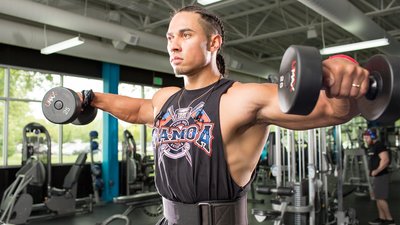Lateral raises sometimes get cast as a "pure aesthetics" movement, but in actuality, they offer far more than just looks. If you want to build strong and healthy shoulders, lateral raises need to be a mandatory cornerstone movement in your programming.
But if you are experiencing chronic, nagging shoulder pain during pressing and direct shoulder work, chances are good the way you perform lateral raises isn't helping. Despite its seeming simplicity, it's very easy to butcher the lateral raise, making this theoretically joint-friendly staple movement pattern a painful, weakness-exacerbating exercise.
When it comes to programming and executing lateral raise variations, there's a right way that unlocks muscular size and strength potential, and there's a wrong way that leave you broken down and hurt in the process.
Here's how to use this bodybuilding staple to help you bulletproof your shoulders once and for all, and boost growth in the process.
Dial in Your Standing Dumbbell Raise Technique First
Before you go rewriting the lateral raise book and reverse engineering your programming due to shoulder pain or plateaus, make sure you're locked in on the key cues in the foundational version of the lift, the two-dumbbell standing version.
Full-Body Tension: First, ensure that your entire body is creating tension, from your feet rooting into the floor to your glutes, adductor, and core all contracting together. If you create proper full-body tension, you'll find yourself in a slightly hip-hinged position, around 10 degrees of a forward torso angle with the butt pushing back. This will help target the intermediary muscle tissue between the middle and posterior deltoids, which are most often in need of some concentrated work.
Light Grip: Don't grip the dumbbells to death, especially in extended pump sets. Use a loosened grip on the dumbbells in order to limit the amount of muscular "takeover" from the forearm and triceps during the raising portion of the lift. To really take the grip cue one step further, I recommend focusing on squeezing only the pinkie and ring fingers and letting the other three fingers loose. This will help achieve a slightly internally rotated position at the top of the raise that will elicit a stronger contraction.
High Reps: Train this movement with light loading and high reps. Remember, the goal of intelligent hypertrophy training is to hammer the muscles while sparing the joints. We can achieve this in the lateral raise by extending the sets and driving as much blood into the tissues as possible, using this metabolic stress to drive muscle growth.
Superset With Complementary Moves: By adding additional supersets with a circular resistance band, you can elicit a stronger pump effect while minimizing external loads to do the job. Crush sets of 8-12 reps on the dumbbell lateral raise, and follow that up with 5-15 band pull-aparts to maximize the training response. Feel free to add in any banded shoulder staple movements like the face pull or over-and-back into this superset mix Try to program 2-4 total sets, accumulating blood flow into the shoulders throughout each set for the cumulative stress effect.
Utilize Multiple Angles
If you want big, strong, pain-free shoulders, overhead pressing and the occasional half-assed set of heavy lateral raises isn't going to cut it.
Pair the slightly bent-over lateral raise I discussed previously with the bent-over dumbbell rear delt raise in a superset to hammer the lateral, posterior, and intermediary aspects of the deltoids, which are commonly neglected regions of the shoulder complex. This is especially true in those lifters and athletes with chronic aches and pains at the front and tops of their shoulders.
Focus on eliciting quality contractions and peak flexes at the top of each and every rep, and control the eccentric lowering portion of the lift while still flexing the delts hard. Yes, that means you'll be contracting hard even as the weights are lowering, which makes this movement exponentially more mechanically draining to the tissues being targeted. Just 2-3 working sets of around 10 reps will do plenty for you here.
Train It Often
The superset I just discussed can be a game-changer when programmed into training multiple times a week. So when should you do it? About as often as you want.
Of course, this type of scheme fits especially well into upper-body emphasis days, which usually feature both push- and pull-based foundational movement patterns like the bench press, row, pull-up, and overhead press.
But honestly, if you're looking to bring up your shoulders and bulletproof them while you are at it, this type of pump-based scheme can be trained every single day—as long as execution is pristine and loading is intelligent.
Put Two Dumbbells in One Hand
Having trouble not gripping the shit out of the dumbbells as I just commanded? Listen up.
Both deltoids and the stabilizers of the shoulders and scapulae are relatively small muscles. As soon as the grip is maximized, the power of all that neurological irradiation takes over, traveling up the arm and gaining activation from all surrounding musculature.
While irradiation is an amazing thing to target for big compound lifts with near maximum loads, bigger muscles like the triceps and traps tend to take the brunt of the muscular moving emphasis on the lateral raise, hence taking it away from the shoulders, which the lateral raise is trying to target. This is the reason your traps and triceps get pumped doing shoulder work and you are left with shitty results and banged-up shoulders.
If simply lightening the load doesn't keep you from death-gripping, try placing two dumbbells in each hand. This will open up your hand and make it more challenging to over-grip the weights during raises. This also allows you to load these movements with slight pound-by-pound jumps as opposed to only five-pound jumps with a traditional dumbbell set.
Yes, this is a small setup change to your lateral raises, but I promise you that it will revolutionize the way your shoulder training feels almost instantaneously.



